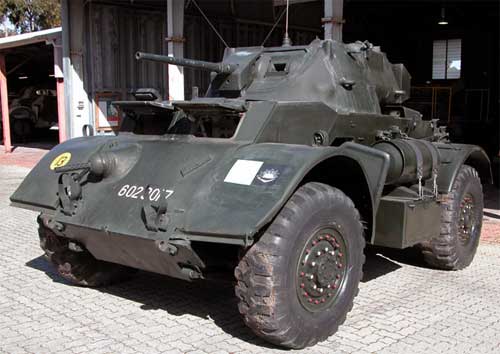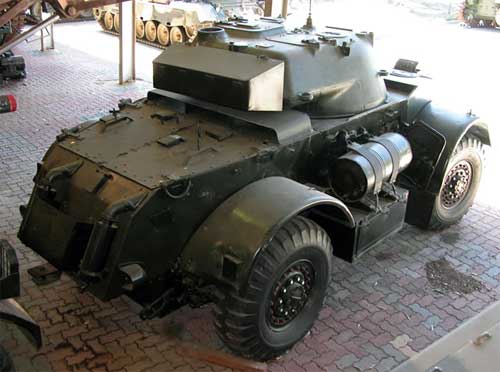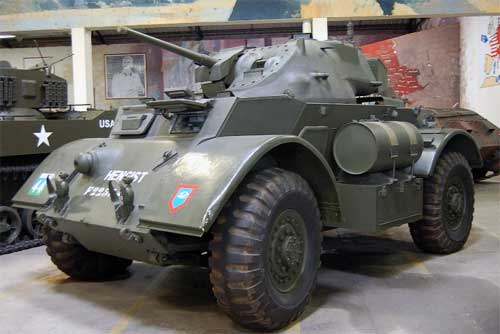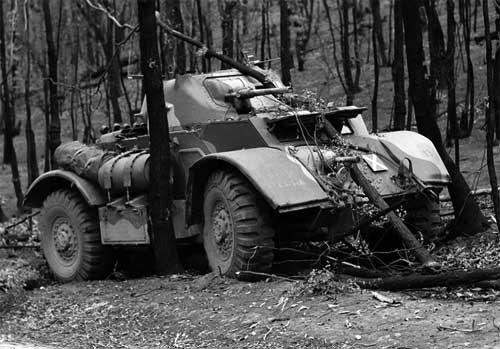
Reconnaissance armored car M6 "Staghound"
Reconnaissance armored car M6 "Staghound"Staghound Armored Car
In the middle there was a fighting compartment. Here, a cast turret of circular rotation was mounted with a 37-mm cannon installed in it and a 7,62-mm machine gun paired with it. Another machine gun was installed in a ball joint in the frontal sheet of the hull. The fire from it was conducted by a radio operator located in the control compartment to the right of the driver. The gearbox installed here had a hydraulic automatic drive. To facilitate control on the steering wheel and drives, servo mechanisms were installed to the brakes. To ensure external communication, the armored car was supplied with a radio station. The armored vehicles were distinguished by high technical reliability, had satisfactory armor and a rational hull and turret configuration.
The M6 Staghound armored car is the heaviest of all used in World War II. The combat weight of this vehicle with a welded main body and a cast turret was 13,9 tons. In fact, it was a wheeled tank, similar in armament and mobility to the light Stuart and inferior to it only in armor, and even then only slightly. The M6 hull was protected by 22 mm frontal and 19 mm side armor. The thickness of the armor plates of the roof was 13 mm, the bottom - ranged from 6,5 mm to 13 mm, the stern of the hull - 9,5 mm. The frontal armor of the tower reached 45 mm, side and aft - 32 mm, roofs - 13 mm. The massive tower was rotated by an electro-hydraulic drive. The crew of the armored car is five people: a driver, an assistant driver (he is also a gunner from a course machine gun), a gunner, a loader and a commander (he is a radio operator). The dimensions of the car were also very impressive and surpassed those of the Stuart. The length of the M6 was 5480 mm, width - 2790 mm, height - 2360 mm, base - 3048 mm, track - 2260 mm, ground clearance - 340 mm.
Armament consisted of a 37-mm M6 cannon, stabilized in the vertical plane, three 7,62-mm Browning M1919A4 machine guns (coaxial with a cannon, course and anti-aircraft) and a 2-inch smoke grenade launcher mounted in the roof of the tower. Ammunition included 103 artillery rounds. 5250 rounds for machine guns and 14 smoke grenades. In addition, the car carried an 11,43 mm Thompson submachine gun. In the aft part of the hull, parallel to the axis of the machine, two 6-cylinder liquid-cooled Chevrolet / GMC 270 in-line carburetor engines were installed; the power of each was 97 hp. at 3000 rpm, working volume 4428 cm3. Transmission - semi-automatic type Hydramatic, which included two four-speed gearboxes (4 + 1), a guitar and a demultiplier. The latter made it possible to turn off the drive of the front axle, and also ensured the movement of the armored car with one engine running. The capacity of the fuel tank was 340 liters. In addition, two external cylindrical fuel tanks with a capacity of 90 liters each were attached to the sides of the vehicle.
The armored car had a 4 × 4 wheel formula and tire size 14,00 - 20 ″. Suspension independent on semi-elliptical leaf springs. Each suspension unit had a hydraulic shock absorber. Due to the use of the Saginaw 580-DH-3 electro-hydraulic power steering, as well as Bendix-Hydrovac hydraulic brakes with a vacuum booster, driving an almost 14-ton combat vehicle was no harder than a passenger car. On the highway, the armored car developed a speed of up to 88 km / h, easily overcame a rise of up to 26 °, a wall 0,53 m high and a ford up to 0,8 m deep. An English radio station No. 19 was installed on all vehicles without exception. The basic modification of the M6 armored car (T17E1 ) in the British army was called the Staghound Mk I. 2844 units of these machines were manufactured.
In addition to linear armored vehicles armed with 37-mm cannons, the British almost immediately showed interest in fire support vehicles. This is how the T17E3 variant was born, which was a standard M6 hull with an open-top turret mounted on it with a 75-mm howitzer borrowed from the American M8 self-propelled gun. However, the British were not interested in this car. They got out of the situation in a different way, re-equipping some of the linear armored cars with a 76-mm tank howitzer of their own production. To free up space for ammunition, the course machine gun was eliminated, and the driver's assistant was excluded from the crew. In addition, a smoke grenade launcher was removed from the tower, and as an alternative, two 4-inch mortars were placed on the right side of the tower for firing smoke grenades. Armored vehicles armed with 76 mm howitzers were named Staghound Mk II.
In an effort to compensate for the insufficiently powerful weapons of the “Staghound” for the second half of the war, on a small number of Mk I modification machines, the British installed turrets from the Crusader III tank with a 75-mm cannon and a 7,92-mm BESA machine gun coaxial with it. Due to the installation of a heavier turret, despite the abandonment of the course machine gun and driver's assistant, the combat weight of the vehicle increased to 15 tons. But the Staghound Mk III variant obtained in this way had significantly greater capabilities to combat enemy tanks than the Mk I. British troops began receiving staghounds in the spring of 1943. Armored vehicles received their baptism of fire in Italy, where they gained a good reputation for their exceptional reliability, ease of operation and maintenance, good armament and armor. The original "African" purpose of the armored car led to a large capacity of fuel tanks and a giant cruising range - 800 km. According to the British crews, the main drawback of the 14-ton wheeled tanks was the lack of a stern control post.
In addition to the British troops, machines of this type entered the New Zealand, Indian and Canadian units that fought in Italy. Received "staghounds" and reconnaissance cavalry regiments of the 2nd Army Corps of the Polish Armed Forces in the West. After the Allies landed in Normandy, armored cars took part in the fighting to liberate Western Europe from the Nazis. In addition to the British and Canadian troops, they were in service with the 1st Polish Panzer Division (in total, the Poles received about 250 armored vehicles of this type) and the 1st separate Belgian tank brigade. After the end of the Second World War, Great Britain had a significant number of “staghounds”. Some of them were used by the troops until the 50s, until they were replaced by more modern English-made armored cars. A large number of machines of this type were transferred or sold to other states. “Staghounds” entered the Belgian army during the war years - one squadron of armored vehicles was armed with them. After the war, their number increased significantly - until 1951, armored vehicles of the Mk I, Mk II and AA modifications formed the basis of three armored cavalry (reconnaissance) regiments. In addition, since 1945, AA version vehicles have been operated in motorized gendarmerie units. In 1952, most of the vehicles from the disbanded armored cavalry regiments were transferred to its composition. In the Belgian gendarmerie, "staghounds" served until 1977. The Dutch army operated several dozen armored vehicles of this type in the period 40-60s (for 1951 there were 108 units). The British handed over to the Danes all armored vehicles of the Mk III modification. Switzerland received a number of Staghound Mk I vehicles. The armament of these armored cars was replaced by the one used in the Swiss army. In the 50s, the staghounds of the Mk I and AA variants entered the Italian army and the Carabinieri Corps. Moreover, on a certain number of vehicles, the 37-mm gun and the Browning machine gun in the turret were replaced by a pair of Breda mod.38 machine guns, and the Browning course machine gun was replaced by a Fiat mod.35 machine gun. In addition to European countries, “staghounds” were supplied to Latin American countries: Nicaragua, Honduras and Cuba.
In the Middle East, the first country to receive "Staghounds" immediately after the end of World War II was Egypt. Two regiments of such armored vehicles were also in service with the Jordanian army. In the 60s, some of the vehicles were transferred to Lebanon, where turrets were installed on them from the British AES Mk III armored cars with 75-mm guns. A similar re-equipment was carried out by "staghounds" in Sudan, but only in the towers borrowed from the armored vehicles of the AES, the 75-mm guns (along with masks) of the Sherman tanks were placed. In addition to the listed countries in the Middle East, "staghounds" were also in the armies of Saudi Arabia and Israel. In Africa, combat vehicles of this type were received by Rhodesia (now Zimbabwe) and South Africa. In the 50s and 60s, they also entered service with India and Australia. At the end of the 70s, there were still about 800 "staghounds" in the armies of various states. Of these, 94 are in Saudi Arabia, 162 in Rhodesia and 448 in South Africa. True, most of the latter were in storage. Performance characteristics
Sources:
|
 The production of the armored vehicle was started in 1943. The armored car was produced in the United States by order of the British army,
The production of the armored vehicle was started in 1943. The armored car was produced in the United States by order of the British army, 





